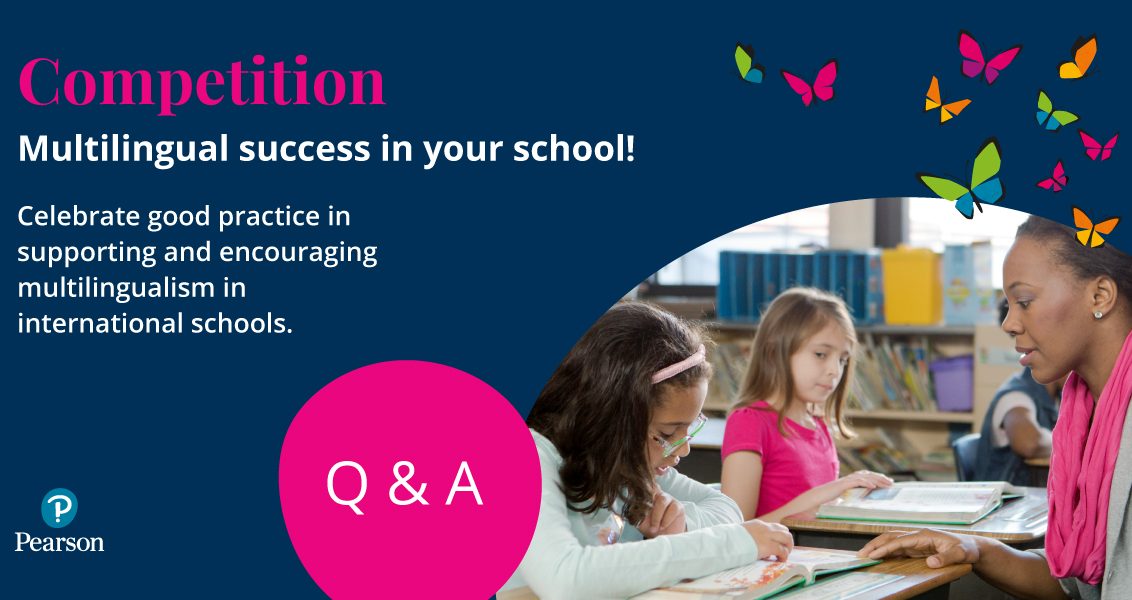
According to ISC Research, 80% of students in international schools are local and speak a plethora of languages, making it no wonder that you had so many questions for bilingualism expert, Eowyn Crisfield, in her recent webinar: Multilingual students in the classroom: what every teacher needs to know.
Read on to discover her expert advice when it comes to best practice for supporting multilingualism in your classroom.
What is translanguaging and what role does it play?
There is a lot of discussion about translanguaging and how it interacts with or contradicts the previously touted ‘target-language only’ belief in language teaching. It is important to understand that context must be considered when deciding how and why to use students’ L1 in the classroom. Although translanguaging pedagogy requires more than a short answer to describe, here are some points to consider:
- When the purpose of the class is to learn the language only (not content), the amount of input that students get is important. L1 can and should be used for scaffolding understanding quickly, and for student support. Because the focus is on language development, the teaching should be appropriate overall for the level of the students, and so they are not clearly disadvantaged by the exclusion of their L1. There is some research from university-level students that indicates that students retain vocabulary items better when they have translated them, so this is a quick and easy strategy teachers can use.
- In schools where the language of instruction is also the language being learned (EMI or other), there are a variety of ways to provide support for content learning and language development through translanguaging pedagogy. We can tap into prior knowledge, scaffold content understanding, and scaffold output through the use of clear pedagogy that involves using L1 in the input, processing, or output phases of a task cycle. The success of translanguaging as a pedagogy rests in teacher task design, that will lead students into productive work in their own languages and then link back to the larger group activities in the language of instruction.
- Translanguaging can also be used to help students develop academic competence in their own languages. We often think that if students’ English is ‘good enough’ they don’t need to engage with their other language, but developing academic competence in the home language, when it is not the language of schooling, is also a challenge. Clear translanguaging pedagogy can ensure that students continue to engage with their own language for learning, and helps continue its development outside the social domain.
Should students take an additional language when they are EAL (host or foreign)?
There is, unfortunately, no current research agenda looking at inclusion/exclusion from additional language classes (host country or foreign language) for students who are learning the school language. This means that schools need to consider their own situation, including their student profile, when making decisions. I see no clear reason (and other scholars agree) for students to be systematically excluded from additional language classes because of their EAL/ELL status. In fact, they may thrive in a beginner language class, as that is the only part of the school day where the expectations are reasonable. It’s lower pressure than the rest of their day – no need to learn content, only focus on language. It’s also a class in which all the others are beginners as well, so it’s a level playing field.
I think it’s particularly important to include students in host country language classes, as these have social as well as linguistic impact. One of the main determiners of inclusion/exclusion is often scheduling; it’s easier to keep students out for EAL/ELL during language classes, as it’s seen as less detrimental to their content learning. But this doesn’t take into account the situation of students who speak the host country language and need to keep it up, or of students who enjoy languages and want to have access to additional languages. International schools need to consider the tripartite needs of their students to acquire the school language, continue their home language, and study the host country language. All three of these should be a priority. With the general rule of inclusion, there should be a provision for exemption from host/foreign if students are over-stressed. These decisions should be made according to the student linguistic profile and pathway. For example, if a child is struggling and distressed in host country language classes, and will only be at the school for a short time, there is a case for exemption. If, however, the child is in the country long-term, then there is a clear reason to persist with host country language learning, and find ways to help the child settle.
Is there a best age for language immersion?
There is certainly support to be found for earlier being better for some aspects of languages acquisition, but by no means for all aspects. The support we have, however, is not as robust as most might think. When we look at simultaneous bilinguals (learning two or more languages from birth) there is clear evidence that this is the most successful way to become bilingual. When we consider the situation of simultaneous bilinguals (languages learned successively) the data is less clear. Longitudinal data from immersion schools in Canada shows that the difference in outcome for early (K-Gr 1), middle (Gr.5-6), and late (Gr.7) is minimal. Students who start in early immersion tend to have better accents, but this is the only statistically significant difference. The middle-late immersion students actually progress at a much faster rate than the early immersion students, and so catch up quite quickly. This is due to the level of cognitive development of the older learners. So earlier isn’t necessarily better, and in some cases could be detrimental.
The priority at all times is that the home language should be supported in continuing to develop, which allows for a strong foundation for the second language development. In immersion situations where the student’s first language is neglected or disallowed, there can be negative impacts on linguistic and academic development. The research from contexts in Africa and Asia, where students are often immersed in a new language at school age with little or no support for the continuing development of their own language shows clearly the negative impact this can have. Therefore, age should be a minor consideration in when to immerse a child in a new school language, secondary to other educational factors that will impact their educational progress. Programmes that support the continued development of the first language alongside the development of the second language have been shown to deliver the best results in terms of L1 acquisition, L2 acquisition, and academic development.
How many languages can (or should) a child be expected to handle?
There is an element of ‘more is better’ when talking about languages and young children which needs to be addressed. Because of the trend to think that children are naturally better at language acquisition there is sometimes a push to have them learn as many languages as possible. There is no clear research base on the issue of ‘how many’, but some basic good sense can help us with guidelines.
The first point to consider is that each language takes a significant amount of time and input to develop. Children are no more likely to develop fluency in minimal amounts of time than adults are. So if their life or school time is divided across many languages, there is a risk that none of them will develop properly. According to Fred Genesee, children need ‘extensive, high-quality input over a long period of time’ to develop fully in a language. All three of those variables need to be addressed if we are aiming for any level of fluency.
A second important point is that children need to develop fully in at least one language. Some bi- or multilingual children can be ‘balanced’ in two (or more) languages eventually, but when they are younger they often have a dominant language (which may change). Ensuring full development of at least one language, to an age-appropriate level, provides a strong base for other languages to develop well also. If children don’t have at least one language that is at the right level for their cognitive level, they risk not being able to access learning, or develop in other languages. When working with parents, I always ask them to make a list of goals for the languages they want their children to learn, and then we look at how much time/effort would be needed to achieve those goals. Through this work, we can often identify when parents have unrealistic expectations for their children in terms of language acquisition.
More on multilingualism
Catch up on Eowyn’s webinar Multilingual students in the classroom: what every teacher needs to know
More posts on the theme of multilingualism:
Debunking the ‘immersion only’ myth
Is there a potential pandemic of language loss in international schools?
Input matters: supporting children’s harmonious bilingual development
Ideas for celebrating International Mother Language Day in your class
Promoting home language use: How do we make a difference?
Multilingual success in your school global competition shortlist
About the author
Eowyn Crisfield is a Canadian-educated specialist in bilingualism, bilingualism in education, and teacher-training. She holds a B.Ed. in Teaching English as a Second/Foreign Language, and a Master of Arts in Applied Linguistics, with specialisations in language learning and teaching, and bilingual education. Eowyn has over 20 years of experience in the field of Applied Linguistics, and has a background that covers research, teaching and teacher-training, and supporting bilingual families. She is currently an Associate Lecturer at Oxford Brookes University, lecturing on the Post-Graduate Certificate in Teaching Multilingual Learners and the MA TESOL.

